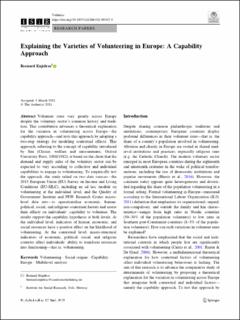| dc.description.abstract | Volunteer rates vary greatly across Europe despite the voluntary sector’s common history and tradition. This contribution advances a theoretical explanation for the variation in volunteering across Europe—the capability approach—and tests this approach by adopting a two-step strategy for modeling contextual effects. This approach, referring to the concept of capability introduced by Sen (Choice, welfare and measurement, Oxford University Press, 1980/1982), is based on the claim that the demand and supply sides of the voluntary sector can be expected to vary according to collective and individual capabilities to engage in volunteering. To empirically test the approach, the study relied on two data sources—the 2015 European Union (EU) Survey on Income and Living Conditions (EU-SILC), including an ad hoc module on volunteering at the individual level, and the Quality of Government Institute and PEW Research Center macrolevel data sets—to operationalize economic, human, political, social, and religious contextual factors and assess their effects on individuals’ capability to volunteer. The results support the capability hypothesis at both levels. At the individual level, indicators of human, economic, and social resources have a positive effect on the likelihood of volunteering. At the contextual level, macro-structural indicators of economic, political, social, and religious contexts affect individuals’ ability to transform resources into functioning—that is, volunteering. | |
